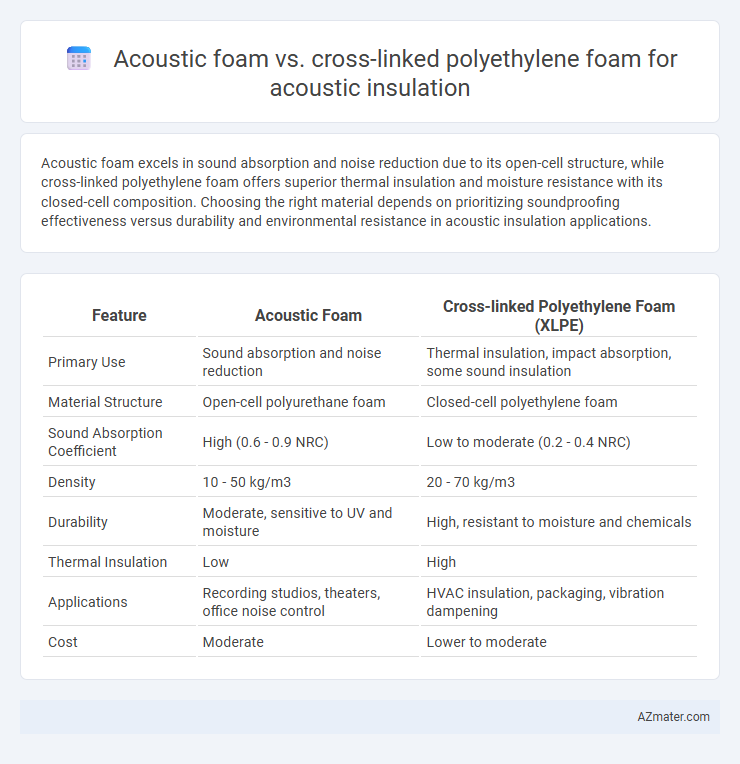Acoustic foam excels in sound absorption and noise reduction due to its open-cell structure, while cross-linked polyethylene foam offers superior thermal insulation and moisture resistance with its closed-cell composition. Choosing the right material depends on prioritizing soundproofing effectiveness versus durability and environmental resistance in acoustic insulation applications.
Table of Comparison
| Feature | Acoustic Foam | Cross-linked Polyethylene Foam (XLPE) |
|---|---|---|
| Primary Use | Sound absorption and noise reduction | Thermal insulation, impact absorption, some sound insulation |
| Material Structure | Open-cell polyurethane foam | Closed-cell polyethylene foam |
| Sound Absorption Coefficient | High (0.6 - 0.9 NRC) | Low to moderate (0.2 - 0.4 NRC) |
| Density | 10 - 50 kg/m3 | 20 - 70 kg/m3 |
| Durability | Moderate, sensitive to UV and moisture | High, resistant to moisture and chemicals |
| Thermal Insulation | Low | High |
| Applications | Recording studios, theaters, office noise control | HVAC insulation, packaging, vibration dampening |
| Cost | Moderate | Lower to moderate |
Introduction to Acoustic Foam and Cross-Linked Polyethylene Foam
Acoustic foam is specially designed to reduce sound reflections and improve room acoustics by absorbing high-frequency noise, commonly made from open-cell polyurethane materials. Cross-linked polyethylene foam features a closed-cell structure, providing excellent thermal insulation and sound dampening by trapping air within its resilient matrix. Both materials serve different acoustic insulation purposes, with acoustic foam targeting sound absorption and cross-linked polyethylene foam offering noise blocking and impact resistance.
Key Properties of Acoustic Foam
Acoustic foam exhibits open-cell structure with high porosity, enabling efficient sound absorption by trapping and dissipating sound waves. Its lightweight, open-cell polyurethane or melamine composition provides excellent noise reduction and echo control, especially in mid to high-frequency ranges. This contrasts with cross-linked polyethylene foam's closed-cell structure, which offers superior impact resistance and moisture barrier properties but lower acoustic absorption efficiency.
Key Properties of Cross-Linked Polyethylene Foam
Cross-linked polyethylene foam exhibits excellent thermal insulation, high durability, and superior resistance to moisture and chemicals, making it ideal for acoustic insulation applications. Its closed-cell structure provides effective sound absorption and impact cushioning, outperforming many traditional acoustic foams in environments prone to humidity and mechanical stress. The foam's lightweight and flexible nature also allow for easy installation and long-term performance in diverse acoustic treatment settings.
Sound Absorption Capabilities Comparison
Acoustic foam features an open-cell structure that excels in absorbing mid to high-frequency sound waves, making it ideal for reducing echo and reverberation in indoor environments. Cross-linked polyethylene foam, with its closed-cell design, offers limited sound absorption but provides excellent thermal insulation and impact resistance. For superior sound absorption capabilities, acoustic foam outperforms cross-linked polyethylene foam, especially in applications targeting noise reduction and acoustic treatment.
Durability and Longevity Assessment
Cross-linked polyethylene foam exhibits superior durability and longevity compared to acoustic foam, maintaining structural integrity under frequent compression and exposure to moisture. Acoustic foam, while effective in sound absorption, tends to degrade faster due to its open-cell structure, which is more susceptible to wear and environmental factors. For long-term acoustic insulation applications, cross-linked polyethylene foam offers enhanced resilience and sustained performance, making it a preferred choice in demanding environments.
Installation Process and Flexibility
Acoustic foam offers easy installation through adhesive backing or spray adhesives, allowing precise placement for optimal sound absorption, while its flexible, porous structure adapts well to irregular surfaces. Cross-linked polyethylene foam requires more effort during installation, often involving cutting and securing with mechanical fasteners or specialized adhesives, but provides superior resilience and compressive strength, enhancing durability in high-traffic or impact-prone areas. The choice depends on the installation environment and need for flexibility versus toughness, with acoustic foam favoring quick, adaptable setup and cross-linked polyethylene foam suited for robust, long-lasting insulation applications.
Moisture Resistance and Environmental Impact
Acoustic foam, typically made from open-cell polyurethane, offers moderate moisture resistance but can absorb water, reducing its insulating effectiveness over time. Cross-linked polyethylene foam (XLPE) exhibits superior moisture resistance due to its closed-cell structure, preventing water absorption and enhancing durability in damp environments. Environmentally, acoustic foam is less recyclable and may release volatile organic compounds (VOCs), while XLPE foam is more chemically stable but often derived from non-renewable petrochemicals, posing challenges for eco-friendly disposal.
Cost Comparison and Value for Money
Acoustic foam typically costs between $1 to $3 per square foot, offering effective sound absorption for mid to high frequencies, making it a budget-friendly choice for studios and home theaters. Cross-linked polyethylene (XLPE) foam ranges from $2 to $5 per square foot, providing superior durability, thermal insulation, and moisture resistance, often justifying the higher upfront cost with long-term value in industrial or harsh environments. Evaluating cost per performance, acoustic foam delivers better sound-specific insulation at a lower price, while XLPE foam offers broader utility and lifespan benefits, leading to greater value for money in multi-functional applications.
Best Applications for Each Material
Acoustic foam excels in sound absorption, making it ideal for recording studios, home theaters, and vocal booths where reducing echo and reverberation is critical. Cross-linked polyethylene foam offers superior thermal insulation and moisture resistance, commonly used in HVAC systems, pipe insulation, and construction where both sound dampening and environmental protection are needed. Choosing between Acoustic foam and Cross-linked polyethylene foam depends on specific requirements like acoustic performance or durability in variable conditions.
Conclusion: Choosing the Right Acoustic Insulation
Acoustic foam offers superior sound absorption with its open-cell structure, making it ideal for reducing echo and reverberation in indoor environments. Cross-linked polyethylene foam provides excellent thermal insulation and durability, but its closed-cell structure limits its effectiveness for acoustic treatment. Choosing the right acoustic insulation depends on prioritizing sound absorption performance, with acoustic foam preferred for acoustic control and cross-linked polyethylene foam suited for combined thermal and moderate acoustic applications.

Infographic: Acoustic foam vs Cross-linked polyethylene foam for Acoustic insulation
 azmater.com
azmater.com